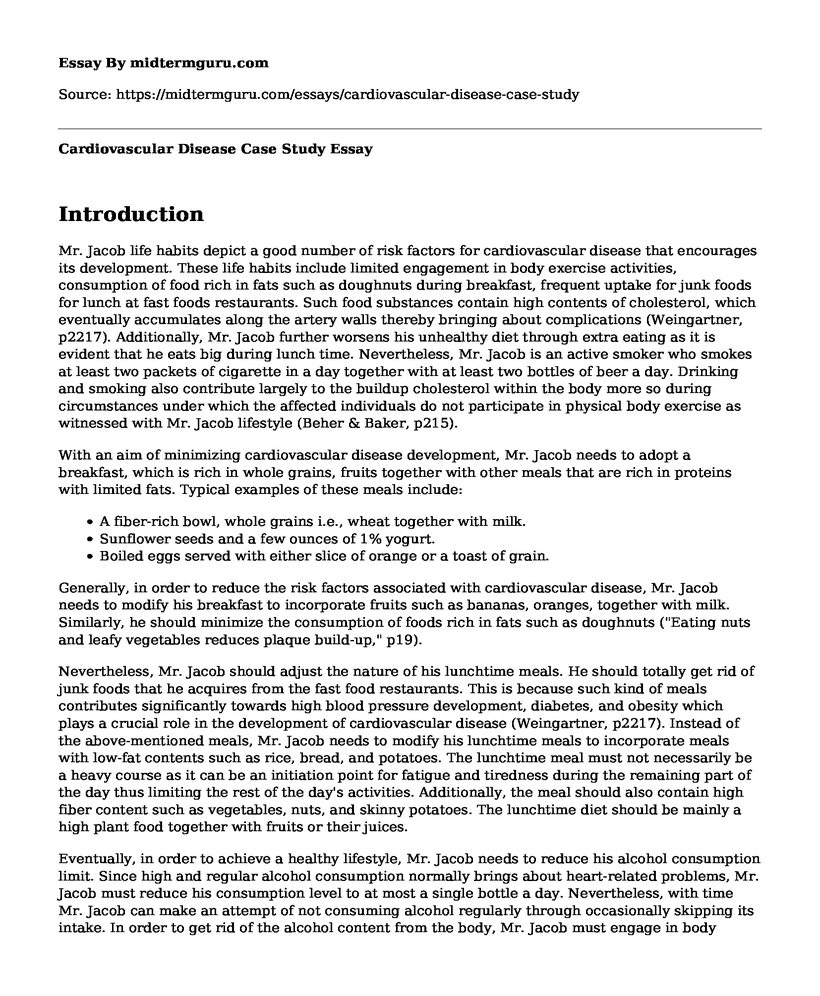Introduction
Mr. Jacob life habits depict a good number of risk factors for cardiovascular disease that encourages its development. These life habits include limited engagement in body exercise activities, consumption of food rich in fats such as doughnuts during breakfast, frequent uptake for junk foods for lunch at fast foods restaurants. Such food substances contain high contents of cholesterol, which eventually accumulates along the artery walls thereby bringing about complications (Weingartner, p2217). Additionally, Mr. Jacob further worsens his unhealthy diet through extra eating as it is evident that he eats big during lunch time. Nevertheless, Mr. Jacob is an active smoker who smokes at least two packets of cigarette in a day together with at least two bottles of beer a day. Drinking and smoking also contribute largely to the buildup cholesterol within the body more so during circumstances under which the affected individuals do not participate in physical body exercise as witnessed with Mr. Jacob lifestyle (Beher & Baker, p215).
With an aim of minimizing cardiovascular disease development, Mr. Jacob needs to adopt a breakfast, which is rich in whole grains, fruits together with other meals that are rich in proteins with limited fats. Typical examples of these meals include:
- A fiber-rich bowl, whole grains i.e., wheat together with milk.
- Sunflower seeds and a few ounces of 1% yogurt.
- Boiled eggs served with either slice of orange or a toast of grain.
Generally, in order to reduce the risk factors associated with cardiovascular disease, Mr. Jacob needs to modify his breakfast to incorporate fruits such as bananas, oranges, together with milk. Similarly, he should minimize the consumption of foods rich in fats such as doughnuts ("Eating nuts and leafy vegetables reduces plaque build-up," p19).
Nevertheless, Mr. Jacob should adjust the nature of his lunchtime meals. He should totally get rid of junk foods that he acquires from the fast food restaurants. This is because such kind of meals contributes significantly towards high blood pressure development, diabetes, and obesity which plays a crucial role in the development of cardiovascular disease (Weingartner, p2217). Instead of the above-mentioned meals, Mr. Jacob needs to modify his lunchtime meals to incorporate meals with low-fat contents such as rice, bread, and potatoes. The lunchtime meal must not necessarily be a heavy course as it can be an initiation point for fatigue and tiredness during the remaining part of the day thus limiting the rest of the day's activities. Additionally, the meal should also contain high fiber content such as vegetables, nuts, and skinny potatoes. The lunchtime diet should be mainly a high plant food together with fruits or their juices.
Eventually, in order to achieve a healthy lifestyle, Mr. Jacob needs to reduce his alcohol consumption limit. Since high and regular alcohol consumption normally brings about heart-related problems, Mr. Jacob must reduce his consumption level to at most a single bottle a day. Nevertheless, with time Mr. Jacob can make an attempt of not consuming alcohol regularly through occasionally skipping its intake. In order to get rid of the alcohol content from the body, Mr. Jacob must engage in body exercise activities such as evening jogging. This would also contribute towards stabilization of his heart rates. Finally, Mr. Jacob must also reduce his active smoking to a manageable quantity of cigarettes as he moves towards a complete halt. This is because smoking also possesses similar dangers as to alcohol. At some point, it initiates more health issues than alcohol as it also affects the lungs.
Works Cited
Beher, W. T., and G. D. Baker. "Build-Up and Regression of Inhibitory Effects of Cholic Acid on in vivo Liver Cholesterol Synthesis." Experimental Biology and Medicine, vol. 101, no. 2, 1959, pp. 214-217, doi: 10.3181/00379727-101-24887.
"Eating nuts and leafy vegetables reduces plaque build-up." Nursing Standard, vol. 19, no. 48, 2005, pp. 19-19, doi:10.7748/ns.19.48.19.s22.
Weingartner, O. "Cholesterol-Lowering Foods, and Reduction in Serum Cholesterol Levels." JAMA, vol. 306, no. 20, 2011, p. 2217, doi:10.1001/jama.2011.1719.
Cite this page
Cardiovascular Disease Case Study. (2022, Sep 12). Retrieved from https://midtermguru.com/essays/cardiovascular-disease-case-study
If you are the original author of this essay and no longer wish to have it published on the midtermguru.com website, please click below to request its removal:
- A Comparative Study of Social Media Platforms Used by the Well-Being Sector
- Pathophysiology of Gastric Acid Stimulation and Production - Essay Sample
- Personal Statement on Doctorate in Clinical Social Work
- Nurse Staffing Patterns: Balancing Quality, Productivity & Morale - Essay Sample
- Nurses' Managers: Leadership Styles & Job Satisfaction in Healthcare - Essay Sample
- Automation in Hospitality & Tourism: How Technology is Transforming the Industry - Essay Sample
- Nursing Priorities: Ranking NAND-Approved Diagnoses - Essay Sample







